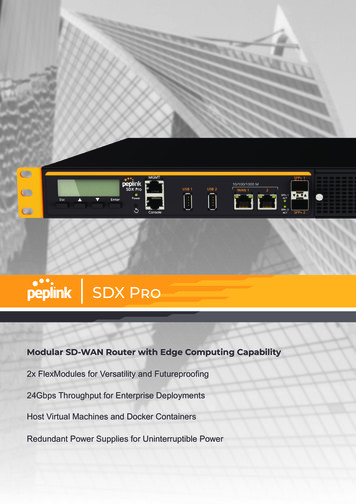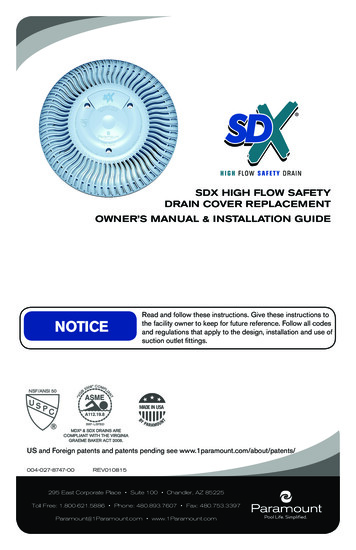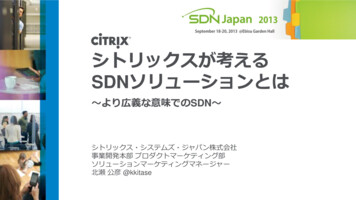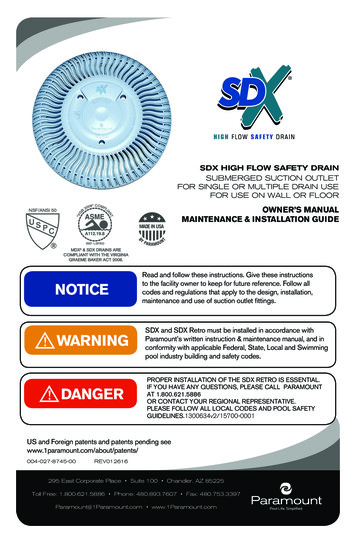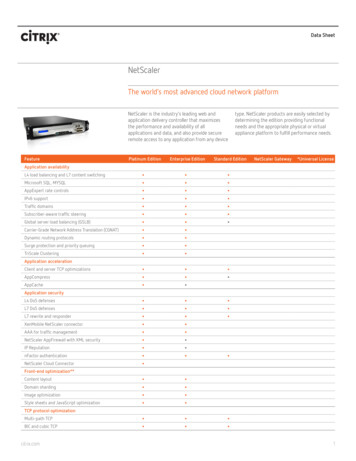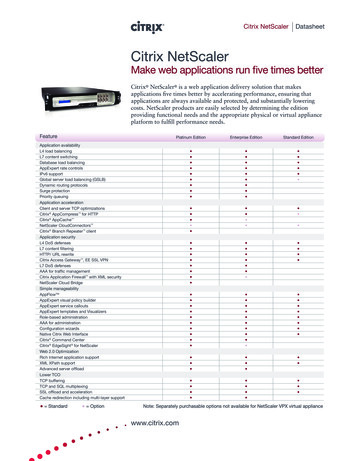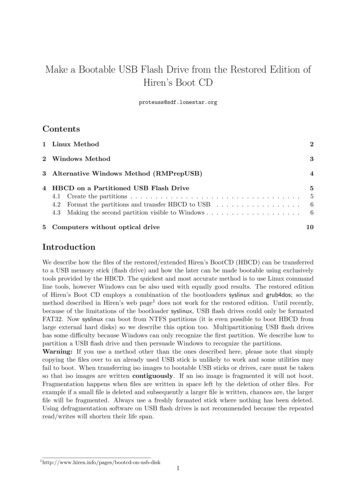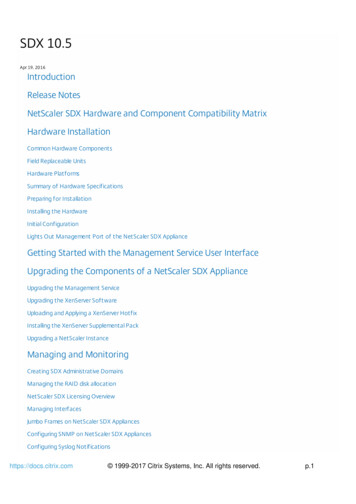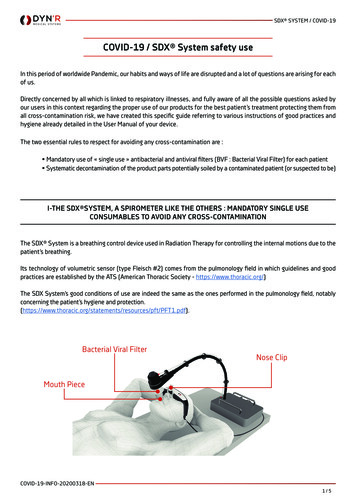
Transcription
SDX SYSTEM / COVID-19COVID-19 / SDX System safety useIn this period of worldwide Pandemic, our habits and ways of life are disrupted and a lot of questions are arising for eachof us.Directly concerned by all which is linked to respiratory illnesses, and fully aware of all the possible questions asked byour users in this context regarding the proper use of our products for the best patient’s treatment protecting them fromall cross-contamination risk, we have created this specific guide referring to various instructions of good practices andhygiene already detailed in the User Manual of your device.The two essential rules to respect for avoiding any cross-contamination are : Mandatory use of « single use » antibacterial and antiviral filters (BVF : Bacterial Viral Filter) for each patient Systematic decontamination of the product parts potentially soiled by a contaminated patient (or suspected to be)I-THE SDX SYSTEM, A SPIROMETER LIKE THE OTHERS : MANDATORY SINGLE USECONSUMABLES TO AVOID ANY CROSS-CONTAMINATIONThe SDX System is a breathing control device used in Radiation Therapy for controlling the internal motions due to thepatient’s breathing.Its technology of volumetric sensor (type Fleisch #2) comes from the pulmonology field in which guidelines and goodpractices are established by the ATS (American Thoracic Society - https://www.thoracic.org/)The SDX System’s good conditions of use are indeed the same as the ones performed in the pulmonology field, notablyconcerning the patient’s hygiene and sources/pft/PFT1.pdf).Bacterial Viral FilterNose ClipMouth PieceCOVID-19-INFO-20200318-EN1/5
SDX SYSTEM / COVID-19As mentioned in your product’s user manual, the single use of antibacterial filters is mandatory for avoiding anycross-contamination between your patients breathing in the SDX System. For each patient, you will also have to use anose-clip and a mouthpiece for avoiding any oral and nasal leakage.The role of the antibacterial filter is to create a protective barrier between the patient and the breathing tube (or honeycomb tube), for avoiding that any virus or bacterium contaminates the other part.In these conditions of SDX System’s good use, there is none cross-contamination risk between your patients,as long as the antibacterial filters that you are using meet the applicable international standards.The great majority of antibacterial filters supplied in pulmonology for practicing PFT (Pulmonary Function Testing)meet the ATS requirements, but in case of any doubt concerning the filters that you are using, please urgently consultthe manufacturer for asking the tests reports (realized by independent laboratories such as Nelson Laboratories)certifying that the filter’s membranes are answering well to the following criteria :Specifications ATS/ERS : 1,5 cm H2O/lps for a débit of 12 l/sec – Efficiency of the electrostaticmembrane : 99,9999 % concerning bacterium (BFE) : 99,999 % concerning virus (VFE)Strictly respecting these conditions and with regard to the size of the COVID-19 virus (Cf. Letter addresed by our partnerGVS to its clients using their filters branded GVS in PFT), the filters that you are using will perfectly prevent from anycontamination via this type of virus.II-CLINICAL USE OF THE SDX SYSTEM: CLEANING & DISINFECTION RECOMMENDATIONWith the current pandemic and knowing that any patient could be infected, even without any clinical symptoms,DYNR recommends a systematic disinfection of every parts of the SDX System that could have been contaminatedby the patient.There are two parts of the SDX System that can be possiblycontaminated: The parts of the product in direct contact (or thatcould be in direct contact) with the patient (e.g:video goggle) The parts into which the patient is breathing (breathing tube)COVID-19-INFO-20200318-EN2/5
SDX SYSTEM / COVID-19II.1 - Parts in direct contact with the patientThe SDX System is designed to allow the cleaning of everyexternal part. That cleaning can be done with medical gradealcohol-free (or low alcohol) wipes.SDX Video gogglesSDX TrolleySDX ModuleAfter every patient’s treatment, it is strongly recommended to clean & disinfect the video goggles that were in directcontact with the patient’s skin.Use of an eye-shield:The direct contact with the patient’s skin can be reduced byusing an eye-shield. When using an eye-shield, the numberof parts in contact with the patient’s skin is reduced: the eyeshield, the nasal back curve and the goggles temples (placedon the ears)It is recommended to remove the eye-shield before cleaning &disinfection of the video goggles.WARNING: The lenses of the video goggles are recovered by a plastic that can be easily scratched if cleaned withabrasive products. It is recommended to use a microfiber cleaning pad soaked with a little quantity of saline solution.Directly spray the solution on the lenses, carefully wipe away by doing a slow circular movement until the lenses arecleaned & dry.The remaining surface of the video goggles and eye-shield can be cleaned and disinfected by using a disinfectant wipewith low alcohol content (or alcohol-free). The same wipe must be used only one time on the video goggles / eye-shield.COVID-19-INFO-20200318-EN3/5
SDX SYSTEM / COVID-19II.2 - The breathing tube (« Honey Comb Tube »)The main part of the Spirometry sensor is the breathingtube (or “Honey Comb Tube”) to which the antibacterialfilters are connected. It is in this part that the patient’sfiltered air will pass both in inspiration and expiration.The antibacterial filter is acting as a bacterial & viral barrier (as explained above) but it can happen that a patienttouches the tube with his hands, or coughs in the Honey Comb Tube direction before or after that the antibacterialfilter was correctly plugged In such a situation, as indicated in your product User Manual, the breathing tube can beeasily removed for cleaning with appropriate solutions.The Honey Comb Tube is an assembly of different elements (tube, security locking, central axe, sheet metal strip) allmade with austenitic stainless steel.The two following products were tested and are recommended by DYN’R for the decontamination of the SDX SystemHoney Comb Tube :BACTINYL 6G PE is a high-grade glutaraldehyde disinfectant for endoscopes, surgical medical instruments andnon-sterilizable equipment, medical devices.CLASS IIB. Bactericidal : NF EN 13727, NF EN 14561 Mycoactericidal : NF EN 14348, EN 14563 Fungicidal : NF EN 13624, EN 14652 Sporicidal : EN 14347 Virucidal : NF EN 14476 sur Poliovirus, Adenovirus, Herpes simplex virus, Pseudorabies virusCIDEX OPAInstrument high performance Disinfectant. Offers a high level of disinfection Contains ortho-phtaladehyde (0.55 %) Glutaraldehyde free with minimal odor Reusable for up to 14 days Easy to rinse Soak Time – 10 hours at 20 C and 25 C : Bactericidal, tuberculocidal, virucidal (including HIV-1)and fungicidal properties Soak Time – 32 hours at 20 C and 25 C : Sporicidal properties May be disposed of down the sink according to local regulationsCOVID-19-INFO-20200318-EN4/5
SDX SYSTEM / COVID-19Recommended procedure for cleaning, disinfecting and rinsing of the breathing tube :01 - Wear appropriate personal protective equipment and read the instructions of your disinfectant product, to possibly adapt the procedure recommended below;02 - Fill a clean sink or an appropriate size receptacle (do not use a hand basin); alternatively, an ultrasonic cleanerwith appropriate water and detergent may be used. The detergent dilution and water temperature should be inaccordance with the manufacturer’s instructions and local policies. Note : the use of the ultrasonic bath is toprovide an additional cleaning mean of any physical particle or dirt on the Honey Comb tube;03 - Fully submerge the parts in the detergent solution. Ensure that no air bubbles remain in lumens or serrations, byirrigating them with running water;04 - Gently agitate the parts to remove all visible dirt, taking care to keep the device under the surface of the waterto prevent splashing and spraying or leave the Ultra sound cleaner running for the recommended time;05 - Remove the item from the sink or from the machine and drain any excess detergent prior to submerging the itemin a second sink or receptacle containing clean rinsing water;06 - Rinse the item thoroughly with clean and cold running water;07 - Remove and drain the device and then dry it thoroughly using clean and oil free compressed air;08 - After cleaning, dispose of any cleaning materials safely in the appropriate waste containers in accordance withyour local policy;09 - Carefully inspect all surfaces and gaps of the internal parts of the Honey Comb tube. These parts must be perfectlyclean and free of particles and/or dirt. Inspect the matrix and capillaries for detecting possible mechanical damagesand/or remaining dirt in the airflow path of the matrix;10 - Remove your personal protective equipment and decontaminate your hands;11 - Complete any necessary documentation to record that you have cleaned the device and to describe the methodand solutions you used;12 - After repositioning the Honeycomb Tube, be sure to check the calibration of your device before any new use (seeCalibration procedure and Calibration check in your user manual).Please feel free to contact us if you have any question or if you need any additional information.DYN’R Technnical Support Contacts:Europe & AsieDYN’R Technical Support 33 6 42 74 19 66 33 4 42 21 07 34maxim@dynr.comUnited States of AmericaDYN’R US Technical Support 1 (786) 832-2133 1 (213) 306-1513noel@dynr.comCOVID-19-INFO-20200318-EN5/5
SDX SYSTEM / COVID-19 COVID-19-INFO-20200318-EN 1 / 5 COVID-19 / SDX System safety use In this period of worldwide Pandemic, our habits and ways of life are disrupted and a lot of questions are arising for each of us. Directly concerned by all which is linked to respiratory illnesses, and fully aware of all the possible questions asked by

